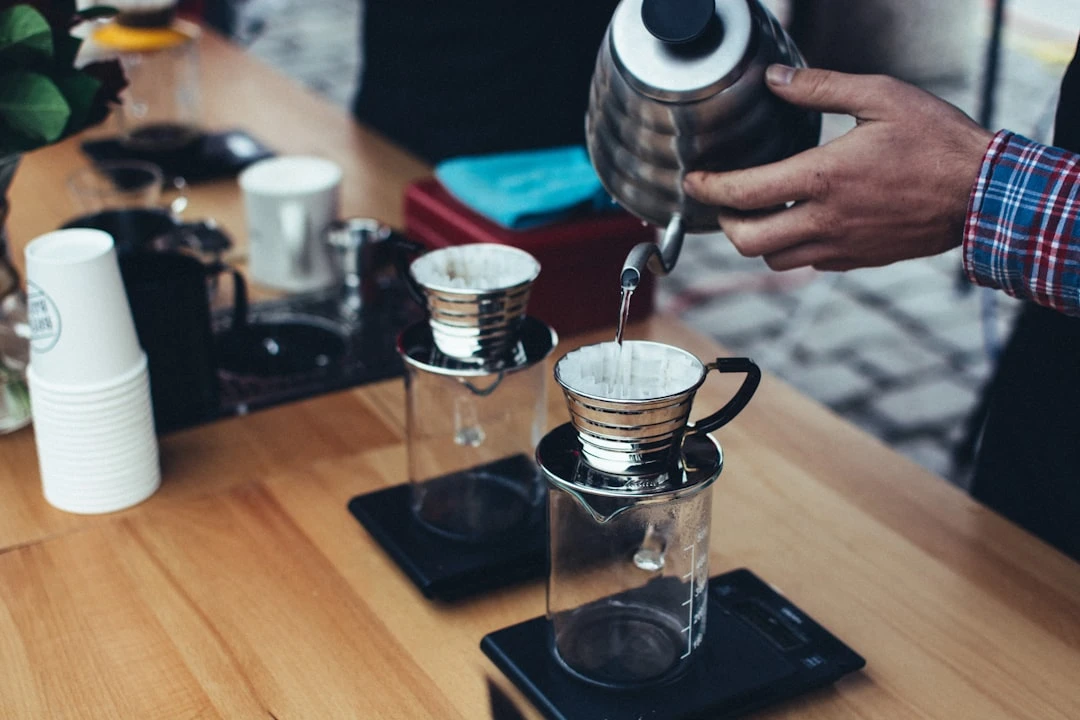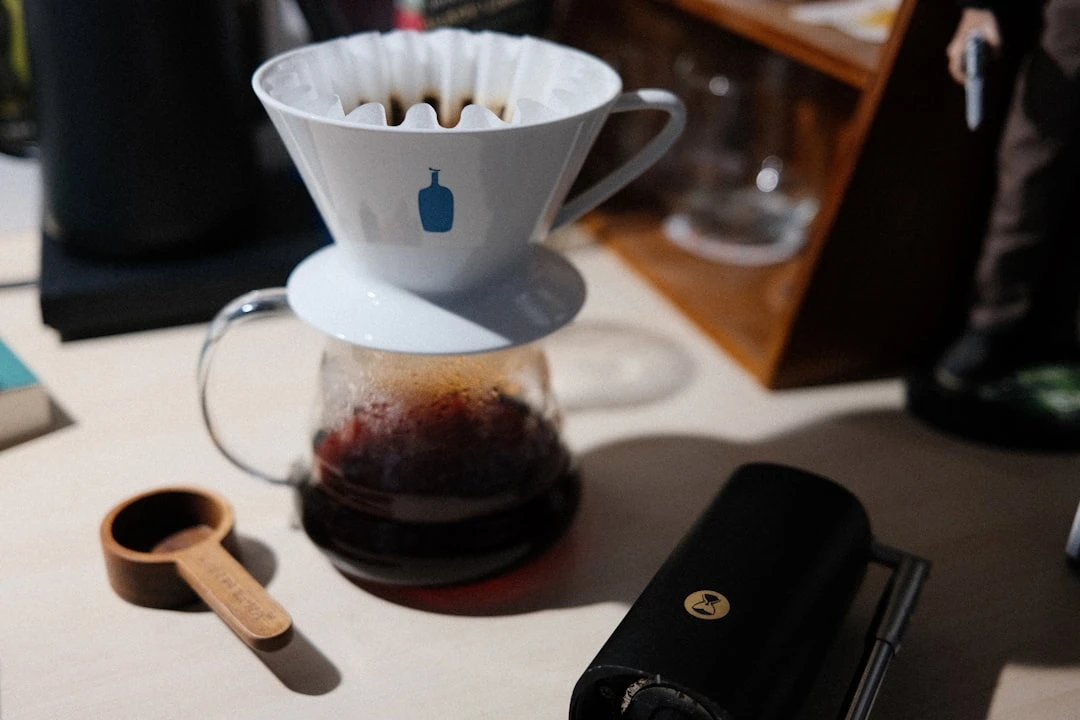Coffee Brewing Turbulence: Why Water Movement Makes or Breaks Your Perfect Cup

Here's something that'll blow your mind: 60% of coffee extraction happens in the first 30 seconds of brewing, and most of that depends on how your water moves through the grounds. I learned this the hard way after months of wondering why my expensive single-origin beans tasted like bitter disappointment every morning.
See, I used to think brewing great coffee was all about the beans and the grind. Wrong! It wasn't until I accidentally knocked my pour-over kettle while brewing one morning that I discovered the secret. That clumsy bump created this perfect swirling motion in my coffee bed, and suddenly I had the most balanced, flavorful cup I'd ever made at home.
That's when I dove deep into the world of coffee brewing turbulence – the often-overlooked science of how water movement affects every sip you take. In this guide, I'll share everything I've learned about controlling turbulence across different brewing methods, from the gentle art of French press agitation to the precise physics of espresso flow. You're gonna discover why that expensive coffee setup isn't delivering the goods, and more importantly, how to fix it without buying more gear.
What Is Coffee Brewing Turbulence and Why Does It Matter?
Let me start with a confession: I used to think turbulence was just a fancy word baristas threw around to sound smart. Boy, was I wrong. Coffee brewing turbulence is simply how water moves through your coffee grounds during extraction, and it's absolutely crucial for pulling out all those amazing flavors you paid good money for.
Think of it like this – your coffee grounds are like a sponge, and water needs to find every nook and cranny to extract the oils, acids, and sugars that make coffee taste incredible. Without proper turbulence, water takes the path of least resistance, leaving some grounds bone dry while over-extracting others. That's why you get those cups that taste both weak and bitter at the same time. Frustrating as hell, right?
Here's where most people mess up: they think more agitation always equals better extraction. I made this mistake for years, stirring my French press like I was making soup and wondering why my coffee tasted harsh and over-extracted. The truth is, different brewing methods need different types of turbulence. Some need gentle, controlled movement, while others benefit from more aggressive agitation.
The science behind this is actually pretty cool. When water hits coffee grounds, it creates what's called a "boundary layer" – basically a thin film of concentrated coffee liquid that forms around each particle. Without proper turbulence to break up these layers, extraction becomes uneven and incomplete. That's why professional baristas are so obsessed with pouring techniques and timing – they're manipulating turbulence to get consistent results.
I remember the first time I really understood this concept. I was experimenting with my V60 and noticed that when I poured in a steady, circular motion, the coffee bed would create these beautiful spiraling patterns. But when I just dumped all the water in at once, the grounds would form channels and valleys, leaving some areas completely untouched by water. The difference in taste was night and day – the controlled pour gave me bright, complex flavors while the dump method produced flat, lifeless coffee.
The Physics Behind Perfect Pour-Over Turbulence
Pour-over brewing is where turbulence control really shines, and honestly, it's where I made some of my biggest mistakes early on. I used to think pouring faster meant stronger coffee, but that just created chaos in my coffee bed and ruined everything.
The key to pour-over turbulence is understanding water flow dynamics. When you pour water onto coffee grounds, you're creating a mini ecosystem where gravity, surface tension, and particle size all work together. The grind size particularly affects how water moves through the bed – finer grinds create more resistance and need gentler pouring, while coarser grinds can handle more aggressive turbulence.
Here's what I learned through countless ruined Saturday morning brews: the optimal pouring technique creates controlled turbulence that ensures even saturation without over-agitation. I start with a slow, spiral pour from the center outward, keeping my kettle about two inches above the grounds. This creates just enough turbulence to break up dry pockets without disturbing the coffee bed too much.
The bloom phase is crucial for setting up proper turbulence patterns. When you first wet the grounds, they release CO2 and create this beautiful, puffy dome. I used to rush this step, but now I pour just enough water to saturate the grounds (usually twice the coffee weight) and wait 30-45 seconds. This allows the grounds to degas and settle into a configuration that promotes even water flow during the main pour.
Equipment makes a huge difference in controlling turbulence. I upgraded from a regular kettle to a gooseneck kettle, and the difference was incredible. The narrow spout gives you precise control over flow rate and pour placement, which directly translates to better turbulence management. You don't need to spend a fortune – even a basic gooseneck kettle will transform your pour-over game.
Temperature also plays a role in turbulence behavior. Hotter water (around 205°F) creates more vigorous movement and faster extraction, while cooler water (around 195°F) produces gentler turbulence and slower extraction. I adjust my water temperature based on the coffee I'm brewing – lighter roasts get the hotter water to boost extraction, while darker roasts get cooler water to avoid over-extraction.
French Press Turbulence: The Gentle Giant Approach
The French press taught me that sometimes less is more when it comes to brewing turbulence. This brewing method is all about gentle, controlled agitation that enhances extraction without creating chaos in your coffee bed.
Here's where I screwed up for years: I treated my French press like a cocktail shaker, stirring vigorously and pressing down hard on the plunger. The result? Over-extracted, bitter coffee that made me question why anyone liked French press brewing. The truth is, French press extraction happens primarily through time and temperature, not aggressive agitation.
The proper French press turbulence technique is surprisingly gentle. After adding hot water to your grounds, I give the mixture one or two gentle stirs with a wooden spoon or plastic paddle – never metal, which can crack the carafe. The goal is to ensure all grounds are saturated, not to create a whirlpool. Then I let physics do the work during the four-minute steeping time.
Timing your agitation is crucial for French press success. I do my initial gentle stir immediately after adding water, then let it sit undisturbed for about 3.5 minutes. At this point, I break the crust that forms on top with a spoon and give one final, very gentle stir before plunging. This technique maximizes extraction while minimizing the bitter compounds that come from over-agitation.
Temperature considerations are especially important for French press turbulence because of the long contact time. I use water that's slightly cooler than pour-over brewing – around 200°F – because the extended steeping time compensates for the lower temperature. Hotter water combined with the natural turbulence of a four-minute immersion can lead to over-extraction and harsh flavors.
The pressing technique itself affects turbulence patterns in ways I never considered before. I used to slam the plunger down like I was trying to crush something, but that just forces fine particles through the filter and creates muddy coffee. Now I press slowly and steadily, taking about 30 seconds to complete the plunge. This gentle pressure maintains the coffee bed structure while filtering out the grounds.
Espresso Turbulence: Pressure, Flow, and Channeling
Espresso brewing is where turbulence control gets really technical, and honestly, it's where I felt most out of my depth when I first started. The combination of pressure, fine grinds, and short extraction time makes turbulence absolutely critical for preventing channeling and achieving even extraction.
Channeling is the espresso killer – when water finds the path of least resistance through your coffee puck, creating uneven extraction that tastes sour and weak. I struggled with this for months on my home espresso machine until I learned that proper turbulence starts before the water even touches the coffee.
Pre-infusion is your first line of defense against channeling. This is where the machine slowly introduces water at low pressure to gently saturate the coffee grounds before full extraction begins. I set my machine to pre-infuse for 3-5 seconds, which creates gentle turbulence that evenly wets the puck without disturbing its structure. This initial saturation helps ensure that when full pressure kicks in, water flows evenly through the entire coffee bed.
Grind distribution plays a huge role in espresso turbulence. Clumpy, uneven grinds create irregular flow patterns that lead to channeling, while evenly distributed grinds promote uniform turbulence throughout the puck. I learned to use distribution tools – even something as simple as a paperclip works – to break up clumps and level the coffee before tamping.
The tamping technique itself affects turbulence flow. I used to think harder tamping meant better espresso, but that just created an impermeable barrier that forced water to find weak spots in the puck. Now I tamp with consistent pressure (about 30 pounds) and focus on creating a level, even surface that promotes uniform water flow and turbulence.
Professional baristas use something called "profiling" to control turbulence throughout the extraction. This involves varying the pressure during brewing to optimize flavor extraction. While most home machines don't have this capability, I've learned to watch my extraction flow and adjust my grind size to achieve that perfect honey-like stream that indicates proper turbulence and even extraction.
Cold Brew and Turbulence: The Long Game Strategy
Cold brew completely changed my understanding of brewing turbulence because it operates on such a different timeline. While hot brewing methods extract flavors in minutes, cold brew takes hours, which means turbulence requirements are totally different.
The biggest mistake I made with cold brew was treating it like hot coffee brewing. I used to stir aggressively at the beginning, thinking more agitation meant better extraction. What I learned is that cold brew benefits from minimal initial turbulence followed by occasional gentle stirring during the long extraction period.
My cold brew turbulence technique starts with gentle saturation. I add about half my water to the coffee grounds and stir just enough to ensure all grounds are wet – this usually takes 30-60 seconds of gentle stirring with a wooden spoon. Then I add the remaining water slowly to avoid creating excessive turbulence that can lead to over-extraction in the longer steeping time.
Timing agitation during the 12-24 hour extraction period makes a significant difference. I give my cold brew a gentle stir after 4 hours, then again after 8 hours. This redistributes the grounds and prevents them from settling into stagnant layers where extraction becomes uneven. The key word here is gentle – cold brew doesn't need aggressive agitation because time does most of the extraction work.
Equipment modifications can improve cold brew turbulence circulation. I experimented with different containers and found that wider vessels promote better natural circulation than narrow ones. I also tried using a French press for cold brew, which allows for controlled agitation with the plunger during the steeping process. The results were noticeably more even and flavorful.
Temperature affects turbulence behavior even in cold brewing. I've found that starting with room temperature water and then refrigerating after the first few hours creates better initial turbulence than starting with cold water. The slightly warmer water moves more freely through the grounds, creating better saturation before the mixture cools down for long-term extraction.
Troubleshooting Common Turbulence Problems
After years of experimenting with different brewing methods, I've encountered pretty much every turbulence-related problem you can imagine. Here are the most common issues and how to fix them without buying new equipment.
Over-extraction from excessive agitation is probably the most common problem I see. The symptoms are harsh, bitter coffee with astringent aftertastes that make you pucker. This happens when too much turbulence pulls out undesirable compounds from the coffee grounds. The fix is simple but requires restraint: reduce your stirring, pour more gently, and give your coffee bed time to settle between agitations.
Under-extraction from insufficient movement creates the opposite problem – weak, sour coffee that lacks body and sweetness. I experienced this a lot with my French press when I was being too gentle with my stirring. The solution is to increase turbulence gradually until you find the sweet spot. For pour-over, this might mean pouring from a slightly higher position or in smaller, more frequent additions. For French press, it could mean adding one additional gentle stir during steeping.
Identifying channeling and flow issues requires some detective work. In pour-over brewing, I watch for uneven draining patterns or dry spots in the coffee bed after brewing. For espresso, I look for uneven extraction streams or shot timing that's too fast. The visual cues tell you where your turbulence control needs adjustment.
Quick fixes for immediate improvement don't always require new techniques – sometimes it's about adjusting variables you already control. If your coffee tastes uneven, try changing your grind size before modifying your turbulence technique. Coarser grinds often fix channeling issues, while finer grinds can help with under-extraction problems. Water temperature adjustments can also compensate for turbulence issues – slightly cooler water can tame excessive agitation effects, while hotter water can boost extraction when turbulence is too gentle.
The key to troubleshooting turbulence problems is changing one variable at a time. I learned this lesson after countless mornings of disappointing coffee when I tried to fix everything at once. Now when something tastes off, I adjust either grind size, water temperature, or agitation technique – never all three together. This methodical approach helps you understand what's actually causing the problem.
Pro Tips for Mastering Brewing Turbulence at Home
After all my experimentation and mistakes, here are the practical tips that made the biggest difference in my daily brewing routine. These aren't fancy techniques that require expensive equipment – they're simple adjustments that anyone can implement immediately.
The most important tool for controlling turbulence isn't equipment – it's your sense of timing. I keep a simple timer next to my coffee setup and use it religiously. For pour-over, I time my bloom, my pour intervals, and my total brew time. For French press, I time my steeping and plunging. This consistency eliminates one variable so you can focus on perfecting your turbulence technique.
Water pouring technique makes or breaks pour-over turbulence. I learned to pour in concentric circles starting from the center, maintaining a steady flow rate about two inches above the coffee bed. The key is keeping your kettle moving – static pours create uneven saturation and poor turbulence patterns. Practice this motion without coffee first until it becomes second nature.
Grind size adjustment is your secret weapon for turbulence control. When my turbulence technique is perfect but the coffee still tastes off, I adjust the grind first. Finer grinds slow down water flow and can compensate for overly aggressive turbulence, while coarser grinds speed up flow and help when turbulence is too gentle. I keep detailed notes about what grind settings work best for different coffees and brewing methods.
Building consistent daily routines eliminates variables that affect turbulence. I use the same water temperature, the same timing, and the same pouring technique every morning. This consistency means I can identify and fix turbulence problems quickly instead of wondering if it's my technique, my equipment, or my coffee that's causing issues.
The biggest pro tip I can share is to taste your coffee critically and adjust based on what you're experiencing. Harsh, bitter flavors usually mean too much turbulence. Weak, sour flavors typically indicate insufficient turbulence. Once you learn to connect taste with technique, improving your coffee becomes much easier and more intuitive.
Equipment upgrades should be the last resort, not the first. I've achieved dramatic improvements in coffee quality just by modifying my turbulence technique with the same basic equipment I started with. A gooseneck kettle helps with pour-over control, but proper technique with a regular kettle beats poor technique with expensive gear every time.
Conclusion
Understanding coffee brewing turbulence transformed my daily coffee ritual from a frustrating guessing game into a reliable source of cafe-quality drinks at home. The key insight that changed everything for me was realizing that turbulence isn't just about stirring or pouring – it's about understanding how water moves through coffee grounds and learning to control that movement for optimal extraction.
Every brewing method requires its own approach to turbulence control. Pour-over needs precise, controlled agitation to ensure even saturation without over-extraction. French press benefits from gentle, minimal stirring that enhances extraction without creating harshness. Espresso demands careful attention to grind distribution and tamping to prevent channeling. Cold brew requires patience and occasional gentle redistribution during long extraction periods.
The most important lesson I learned is that mastering turbulence isn't about following rigid rules – it's about understanding the principles and then adapting them to your specific coffee, equipment, and taste preferences. Start with the basic techniques I've outlined, but don't be afraid to experiment and make adjustments based on what you're tasting in your cup.
Remember that great coffee is a journey, not a destination. Even after years of focusing on turbulence control, I'm still discovering new nuances and refining my techniques. The beautiful thing about coffee brewing is that there's always room for improvement and experimentation.
Related Articles

How Many Espresso Shots in a Day is Safe For Health?
Read More →
How Long Does Coffee Keep You Awake?
Read More →


